Energy Recovery from Municipal Biodegradable Waste in a Circular Economy
Abstract
1. Introduction
2. Theoretical Background
3. Study Materials
4. Research Methodology
5. Results and Discussion
6. Summary and Development Prospects
- EU Renewable Energy Directive (RED III)—the European Union has committed to achieving a share of 42.5% of energy from renewable sources by 2030.
- Energy Efficiency Directive (EED)—the directive aims to reduce primary and final energy consumption by 11.7% by 2030 compared to projections for 2020.
- Polish Energy Policy until 2040 (PEP2040)—the Polish energy strategy assumes an increase in the share of renewable energy sources in the energy mix and the development of low-carbon technologies.
- Supporting investment in renewable energy sources—this refers to subsidies, tax breaks, and financial support programmes.
Author Contributions
Funding
Data Availability Statement
Conflicts of Interest
References
- Trindade, A.B.; Palácio, J.C.E.; González, A.M.; Orozco, D.J.R.; Lora, E.E.S.; Renó, M.L.G.; Olmo, O.A. Advanced exergy analysis and environmental assessment of the steam cycle of an incineration system of municipal solid waste with energy recovery. Energy Convers. Manag. 2018, 157, 195–214. [Google Scholar] [CrossRef]
- Jonek-Kowalska, I. Towards the reduction of CO2 emissions. Paths of pro-ecological transformation of energy mixes in European countries with an above-average share of coal in energy consumption. Resour. Policy 2022, 77, 102701. [Google Scholar] [CrossRef]
- Soares, R.R.; Miyamaru, E.S.; Martins, G. Environmental performance of the allocation and urban solid waste treatment with energetic reuse through life cycle assessment at CTR-Caieiras. Eng. Sanitária Ambient. 2017, 22, 993–1003. [Google Scholar] [CrossRef][Green Version]
- Balezentis, T. Shrinking ageing population and other drivers of energy consumption and CO2 emission in the residential sector: A case from Eastern Europe. Energy Policy 2020, 140, 111433. [Google Scholar] [CrossRef]
- Kumar, A.; Samadder, S.R. A review of technological options of waste to energy for effective management of municipal solid waste. Waste Manag. 2017, 69, 407–422. [Google Scholar] [CrossRef]
- Themelis, N.J.; Ulloa, P.A. Methane generation in landfills. Renew. Energy 2007, 32, 1243–1257. [Google Scholar] [CrossRef]
- Miłek, D.; Nowak, P.; Latosińska, J. The Development of Renewable Energy Sources in the European Union in the Light of the European Green Deal. Energies 2022, 15, 5576. [Google Scholar] [CrossRef]
- Lino, F.A.M.; Ismail, K.A.R. Evaluation of municipal solid waste treatment as a renewable energy resource in Campinas, Brazil. Sustain. Energy Technol. Assess. 2018, 29, 19–25. [Google Scholar] [CrossRef]
- Rybak, A.; Rybak, A.; Joostberens, J.; Kolev, S.D. Cluster Analysis of the EU-27 Countries in Light of the Guiding Principles of the European Green Deal, with Particular Emphasis on Poland. Energies 2022, 15, 5082. [Google Scholar] [CrossRef]
- Santos, R.E.; Santos, I.F.S.; Barros, R.M.; Bernal, A.P.; Tiago Filho, G.L.; Silva, F.G.B. Generating electrical energy through urban solid waste in Brazil: An economic and energy comparative analysis. J. Environ. Manag. 2019, 231, 198–206. [Google Scholar] [CrossRef]
- Guar, V.K.; Sharma, P.; Awasthi, M.K.; Dussap, C.G.; Pandey, A. Assessing the impact of industrial waste on environment and mitigation strategies: A comprehensive review. J. Hazard. Mater. 2020, 398, 123019. [Google Scholar] [CrossRef] [PubMed]
- Szopik-Depczyńska, K.; Kędzierska-Szczepaniak, A.; Szczepaniak, K.; Cheba, K.; Gajda, W.; Ioppolo, G. Innovation in sustainable development: An investigation of the EU context using 2030 agenda indicators. Land Use Policy 2018, 79, 251–262. [Google Scholar] [CrossRef]
- Rokicki, T.; Perkowska, A.; Klepacki, B.; Bórawski, P.; Bełdycka-Bórawska, A.; Michalski, K. Changes in Energy Consumption in Agriculture in the EU Countries. Energies 2021, 14, 1570. [Google Scholar] [CrossRef]
- Dalmo, F.C.; Simão, N.M.; Nebra, S.; Sant’ana, P.H.M. Energy recovery from municipal solid waste of inter-municipal public consortia identified in São Paulo State. Waste Manag. Res. 2019, 37, 301–310. [Google Scholar] [CrossRef]
- Silva, L.J.V.B.; Santos, I.F.S.; Mensah, J.H.R.; Gonçalves, A.T.T.; Barros, R.M. Incineration of municipal solid waste in Brazil: An analysis of the economically viable energy potential. Renew. Energy 2020, 149, 1386–1394. [Google Scholar] [CrossRef]
- Singh, J.; Laurenti, R.; Sinha, R.; Frostell, B. Progress and challenges to the global waste management system. Waste Manag. Res. 2014, 32, 800–812. [Google Scholar] [CrossRef]
- Marciniuk-Kluska, A.; Kluska, M. Forecasting Energy Recovery from Municipal Waste in a Closed-Loop Economy. Energies 2023, 16, 2732. [Google Scholar] [CrossRef]
- Lino, F.A.M.; Ismail, K.A.R. Recycling and thermal treatment of MSW in a developing country. IOSR J. Eng. 2017, 7, 30–38. [Google Scholar]
- Bórawski, P.; Bełdycka-Bórawska, A.; Szymańska, E.J.; Jankowski, K.J.; Dubis, B.; Dunn, J.W. Development of Renewable Energy Sources Market and Biofuels in The European Union. J. Clean. Prod. 2019, 228, 467–484. [Google Scholar] [CrossRef]
- Pin, B.V.R.; Barros, R.M.; Lora, E.E.S.; Santos, I.F.S. Waste management studies in a Brazilian microregion: GHG emissions balance and LFG energy project economic feasibility analysis. Energy Strategy Rev. 2018, 19, 31–43. [Google Scholar] [CrossRef]
- Golwala, H.; Zhang, X.; Mdlskander, S.; Smith, A.L. Solid waste: An overlooked source of microplastics to the environment. Sci. Total Environ. 2021, 769, 144581. [Google Scholar] [CrossRef] [PubMed]
- Lopes, E.J.; Okamura, L.A.; Maruyama, S.A.; Yamamoto, C.I. Evaluation of energy gain from the segregation of organic materials from municipal solid waste in gasification processes. Renew. Energy 2018, 116, 623–629. [Google Scholar] [CrossRef]
- Jacobson, M.Z.; Delucchi, M.A. Providing All Global Energy with Wind, Water, and Solar Power, Part I: Technologies, Energy Resources, Quantities and Areas of Infrastructure, and Materials. Energy Policy 2011, 39, 1154–1169. [Google Scholar] [CrossRef]
- Wolde-Rufael, Y.; Weldemeskel, E.M. Environmental policy stringency, renewable energy consumption and CO2 emissions: Panel cointegration analysis for BRIICTS countries. Int. J. Green Energy 2020, 17, 568–582. [Google Scholar] [CrossRef]
- Klinghoffer, N.B.; Castaldi, M.J. Waste to Energy Conversion Technology; Woodhead Publishing: Cambridge, UK, 2013. [Google Scholar]
- European Environment Agency (EEA). Bio-Waste in Europe—Turning Challenges into Opportunities; EEA Report No 4/2020; European Environment Agency: Copenhagen, Denmark, 2020. [Google Scholar]
- European Commission. Circular Economy Action Plan. Available online: https://ec.europa.eu/environment/circular-economy/ (accessed on 23 January 2025).
- European Union. Directive 2008/98/EC of the European Parliament and of the Council of 19 November 2008 on waste and repealing certain directives. Off. J. Eur. Union L 2008, 312, 3–30. [Google Scholar]
- Central Statistical Office (CSO). 2025. Available online: https://stat.gov.pl/ (accessed on 26 January 2025). (In Polish)
- Dalmo, F.C.; Simão, N.M.; Lima, H.Q.; Jimenez, A.C.M.; Nebra, S.; Martins, G.; Palacios-Bereche, R.; Sant’ana, P.H.M. Energy recovery overview of municipal solid waste in São Paulo State, Brazil. J. Clean. Prod. 2019, 212, 461–474. [Google Scholar] [CrossRef]
- Kuo, W.C.; Lasek, J.; Słowik, J.; Głód, K.; Jagustyn, B.; Li, Y.H.; Cygan, A. Low-temperature pre-treatment of municipal solid waste for efficient application in combustion systems. Energy Convers. Manag. 2019, 196, 525–535. [Google Scholar] [CrossRef]
- Bajan, B.; Łukasiewicz, J.; Mrówczyńska-Kamińska, A. Energy Consumption and Its Structures in Food Production Systems of the Visegrad Group Countries Compared with Eu-15 Countries. Energies 2021, 14, 3945. [Google Scholar] [CrossRef]
- Astrup, T.F.; Tonini, D.; Turconi, R.; Boldrin, A. Life cycle assessment of thermal Waste-to-Energy technologies: Review and recommendations. Waste Manag. 2015, 37, 104–115. [Google Scholar] [CrossRef]
- Beal, C.M.; King, C.W. The zero-emissions cost of energy: A policy concept. Prog. Energy 2022, 3, 023001. [Google Scholar] [CrossRef]
- Van Eygen, E.; Feketitsch, J.; Laner, D.; Rechberger, H.; Fellner, J. Comprehensive analysis and quantification of national plastic flows: The case of Austria. Resour. Conserv. Recycl. 2017, 117, 183–194. [Google Scholar] [CrossRef]
- Pavi, S.; Kramer, L.E.; Gomes, L.P.; Miranda, L.A.S. Biogas production from co-digestion of organic fraction of municipal solid waste and fruit and vegetable waste. Bioresour. Technol. 2017, 228, 362–367. [Google Scholar] [CrossRef] [PubMed]
- Sebastian, R.M.; Kumar, D.; Alappat, B.J. A technique to quantify incinerability of municipal solid waste. Resour. Conserv. Recycl. 2019, 140, 286–296. [Google Scholar] [CrossRef]
- Jimenez, A.C.M.; Bereche, R.P.; Nebra, S.A. Three municipal solid waste gasification technologies analysis for electrical energy generation in Brazil. Waste Manag. Res. 2019, 37, 631–642. [Google Scholar] [CrossRef]
- Rajaeifar, M.A.; Ghanavati, H.; Dashti, B.B.; Heijungs, R.; Aghbashlo, M.; Tabatabaei, M. Electricity generation and GHG emission reduction potentials through different municipal solid waste management technologies: A comparative review. Renew. Sust. Energy Rev. 2017, 79, 414–439. [Google Scholar] [CrossRef]
- Gajdzik, B.; Wolniak, R.; Grebski, W.W. An econometric model of the operation of the steel industry in Poland in the context of process heat and energy consumption. Energies 2022, 15, 7909. [Google Scholar] [CrossRef]
- Nordi, G.H.; Palacios-Bereche, R.; Gallego, A.G.; Nebra, S.A. Electricity production from municipal solid waste in Brazil. Waste Manag. Res. 2017, 35, 709–720. [Google Scholar] [CrossRef]
- Lopes, E.J.; Queiroz, N.; Yamamoto, C.I.; Costa Neto, P.R. Evaluating the emissions from the gasification processing of municipal solid waste followed by combustion. Waste Manag. 2018, 73, 504–510. [Google Scholar] [CrossRef]
- Rincón-Moreno, J.; Ormazábal, M.; Álvarez, M.; Jaca, C. Advancing circular economy performance indicators and their application in Spanish companies. J. Clean. Prod. 2021, 279, 123605. [Google Scholar] [CrossRef]
- Donati, F.; Aguilar-Hernandez, G.A.; Sigüenza-Sánchez, C.P.; de Koning, A.; Rodrigues, J.F.; Tukker, A. Modeling the circular economy in environmentally extended input-output tables: Methods, software and case study. Resour. Conserv. Recycl. 2020, 152, 104508. [Google Scholar] [CrossRef]
- Ratner, S.; Gomonov, K.; Revinova, S.; Lazanyuk, I. Eco-design of Energy Production Systems: The Problem of Renewable Energy Capacity Recycling. Appl. Sci. 2020, 10, 4339. [Google Scholar] [CrossRef]
- Van Eygen, E.; Feketitsch, J.; Laner, D.; Rechberger, H.; Fellner, J. Kompleksowa analiza i kwantyfikacja krajowych przepływów plastiku: Przypadek Austrii. Resour. Conserv. Recycl. 2017, 117, 183–194. [Google Scholar] [CrossRef]
- Krausmann, F.; Lauk, C.; Haas, W.; Wiedenhofer, D. Od wydobycia zasobów do odpływów odpadów i emisji: Społeczno-ekonomiczny metabolizm światowej gospodarki, 1900–2015. Glob. Environ. Change 2018, 52, 131–140. [Google Scholar] [CrossRef] [PubMed]
- Lyulyov, O.; Chygryn, O.; Pimonenko, T.; Zimbroff, A.; Makiela, Z.; Kwilinski, A. Green competitiveness forecasting as an instrument for sustainable business transformation. Forum Sci. Oeconomia 2024, 12, 8–20. [Google Scholar]
- Confederation of European Waste-To-Energy Plants (CEWEP). Calculation Tool for Potential Impacts on Waste Amounts for Thermal Treatment. Peer Review. Alemanha. 2018. Available online: https://www.cewep.eu/circular-economy-calculator/ (accessed on 30 December 2021).
- Rodrigues, L.F.; Santos, I.F.S.; Santos, T.I.S.; Barros, R.M.; Tiago Filho, G.L. Energy and economic evaluation of MSW incineration and gasification in Brazil. Renew. Energy 2022, 188, 933–944. [Google Scholar] [CrossRef]
- Tabata, T. Waste-to-energy incineration plants as greenhouse gas reducers: A case study of seven Japanese metropolises. Waste Manag. Res. 2013, 31, 1110–1117. [Google Scholar] [CrossRef]
- Ferreira, C.R.N.; Infiesta, L.R.; Monteiro, V.A.L.; Starling, M.C.V.M.; Silva Junior, W.M.; Borges, V.L.; Carvalho, S.R.; Trovó, A.G. Gasification of municipal refuse-derived fuel as an alternative to waste disposal: Process efficiency and thermochemical analysis. Process Saf. Environ. Prot. 2021, 149, 885–893. [Google Scholar] [CrossRef]
- Nordi, G.H.; Palacios-Bereche, R.; Gallego, A.G.; Nebra, S.A. Energetic analysis of electricity production in Rankine cycles from municipal solid waste in Brazil. In Proceedings of the International Solid Waste Association Congress, São Paulo, Brazil, 8–11 September 2014. [Google Scholar]
- Pietrzak, M.B.; Igliński, B.; Kujawski, W.; Iwański, P. Energy transition in Poland—Assessment of the renewable energy sector. Energies 2021, 14, 2046. [Google Scholar] [CrossRef]
- Lima, P.M.; Colvero, D.A.; Gomes, A.P.; Wenzel, H.; Schalch, V.; Cimpan, C. Environmental assessment of existing and alternative options for management of municipal solid waste in Brazil. Waste Manag. 2018, 78, 857–870. [Google Scholar] [CrossRef]
- Themelis, N.J.; Barriga, M.E.D.; Estevez, P.; Velasco, M.G. Guide to Recovering Energy and Materials from Solid Waste, Translation of the original 2013 version; Earth Engineering Center, Columbia University: New York, NY, USA, 2016; 228p. [Google Scholar]
- Commission Implementing Decision (EU) 2021/19 of 18 December 2020 Laying down a Common Methodology and a Format for Reporting on Reuse in Accordance with Directive 2008/98/EC of the European Parliament and of the Council (OJ L 10, 12.1.2021, pp. 1–7). Available online: https://eur-lex.europa.eu/eli/dec_impl/2021/19/oj/eng (accessed on 30 January 2025).
- Commission Decision 2000/532/EC of 3 May 2000 Replacing Decision 94/3/EC Establishing a List of Wastes Pursuant to Article 1(a) of Council Directive 75/442/EEC on Waste and Council Decision 94/904/EC Establishing a List of Hazardous Waste Pursuant to Article 1(4) of Council Directive 91/689/EEC on Hazardous Waste (OJ L 226, 6.9.2000, pp. 3–24). Available online: https://eur-lex.europa.eu/eli/dec/2000/532/oj/eng (accessed on 30 January 2025).
- Commission Implementing Decision (EU) 22019/2000 of 28 November 2019 Laying down a Format for Reporting of Data on Food Waste and for Submission of the Quality Check Report in Accordance with Directive 2008/98/EC of the European Parliament and of the Council (OJ L 310, 2.12.2019, pp. 39–45). Available online: https://eur-lex.europa.eu/eli/dec_impl/2019/2000/oj/eng (accessed on 30 January 2025).
- Commission Delegated Decision (EU) 2019/1597 of 3 May 2019 Supplementing Directive 2008/98/EC of the European Parliament and of the Council as Regards a Common Methodology and Minimum Quality Requirements for the Uniform Measurement of Levels of Food Waste (OJ L 248, 27.9.2019, pp. 77–85). Available online: https://eur-lex.europa.eu/eli/dec_del/2019/1597/oj/eng (accessed on 30 January 2025).
- Commission Directive (EU) 2015/1127 of 10 July 2015 Amending Annex II to Directive 2008/98/EC of the European Parliament and of the Council on Waste and Repealing Certain Directives (OJ L 184, 11.7.2015, pp. 13–15). Available online: https://eur-lex.europa.eu/eli/dir/2015/1127/oj/eng (accessed on 30 January 2025).
- Commission Implementing Decision (EU) 2019/1004 of 7 June 2019 Laying down Rules for the Calculation, Verification and Reporting of Data on Waste in Accordance with Directive 2008/98/EC of the European Parliament and of the Council and Repealing Commission Implementing Decision C(2012) 2384 (OJ L 163, 20.6.2019, pp. 66–100). Available online: https://eur-lex.europa.eu/eli/dec_impl/2019/1004/oj/eng (accessed on 30 January 2025).
- Carneiro, M.L.N.M.; Gomes, M.S.P. Energy, exergy, environmental and economic analysis of hybrid waste-to energy plants. Energy Convers. Manag. 2019, 179, 397–417. [Google Scholar] [CrossRef]
- Marco-Fondevila, M.; Benito-Bentué, D.; Scarpellini, S. “Old” financial instruments in “new” circular models: Applied environmental accounting in the banking sector for reporting in a circular economy. Rev. Contab.-Span. Account. Rev. 2023, 26, 34–45. [Google Scholar] [CrossRef]
- Colvero, D.A.; Ramalho, J.; Gomes, A.P.D.; Matos, M.A.A.; Tarelho, L.A.C. Economic analysis of a shared municipal solid waste management facility in a metropolitan region. Waste Manag. 2020, 102, 823–837. [Google Scholar] [CrossRef] [PubMed]
- Luz, F.C.; Rocha, M.H.; Lora, E.E.S.; Venturini, O.J.; Andrade, R.V.; Leme, M.M.V.; Olmo, O.A. Techno-economic analysis of municipal solid waste gasification for electricity generation in Brazil. Energy Convers. Manag. 2015, 103, 321–337. [Google Scholar] [CrossRef]
- Zaman, A.U. A comprehensive study of the environmental and economic benefits of resource recovery from global waste management systems. J. Clean. Prod. 2016, 124, 41–50. [Google Scholar] [CrossRef]
- Sadeleer, I.; Brattebø, H.; Callewaert, P. Waste prevention, energy recovery or recycling—Directions for household food waste management in light of circular economy policy. Resour. Conserv. Recycl. 2020, 160, 104908. [Google Scholar] [CrossRef]
- Jedelhauser, M. The Future of Waste Incineration in a Modern Circular Economy; Info: Waste Incineration; Naturschutzbund Deutschland (NABU): Berlin, Germany, 2020. [Google Scholar]
- Available online: https://ec.europa.eu/eurostat (accessed on 30 January 2025). (In Polish).
- Available online: https://www.statista.com/topics/4961/renewable-energy-in-europe/ (accessed on 10 February 2025).
- Available online: https://stat.gov.pl/obszary-tematyczne/srodowisko-energia/energia/energia-ze-zrodel-odnawialnych-w-2023-roku,10,7.html (accessed on 30 January 2025). (In Polish)
- Witkowski, M.; Klimanek, T. Economic Forecasting and Simulation in Examples and Tasks; Wydawnictwo Uniwersytetu Ekonomicznego w Poznaniu: Poznan, Poland, 2006; s. 178. (In Polish) [Google Scholar]
- Radzikowska, B. Forecasting Methods. A Collection of Tasks; Wyd. AE we Wrocławiu: Wrocław, Poland, 2000; s.18. (In Polish) [Google Scholar]
- Available online: https://www.gov.pl/afttachmen (accessed on 13 April 2025). (In Polish)
- Available online: https://www.gov.pl/attachment/3c8a2fd6-a0a4-4b7f-b301-0b8569f1eaf7 (accessed on 13 April 2025). (In Polish)
- Klimek, P. Evaluation of the Energy Potential of Municipal Solid Waste Depending on Waste Treatment Technology. Nafta-Gaz, (2013), nr 12, 909–914. (In Polish). Available online: https://www.inig.pl/magazyn/nafta-gaz/NAFTA-GAZ-2013-12-05.pdf (accessed on 30 January 2025).
- Boas Berg, A.; Radziemska, M.; Adamcová, D.; Zloch, J.; Vaverková, M.D. Assessment strategies for municipal selective waste collection-regional waste management. J. Ecol. Eng. 2018, 19, 33–41. [Google Scholar] [CrossRef]
- Mazzanti, M.; Zoboli, R. Waste generation, waste disposal and policy effectiveness: Evidence on decoupling from the European Union. Resour. Conserv. Recycl. 2008, 52, 1221–1234. [Google Scholar] [CrossRef]
- Vieira, V.H.A.D.M.; Matheus, D.R. The impact of socioeconomic factors on municipal solid waste generation in São Paulo, Brazil. Waste Manag. Res. 2017, 36, 79–85. [Google Scholar] [CrossRef]
- Nęcka, K.; Szul, T.; Knaga, J. Identification and analysis of sets variables for of municipal waste management modelling. Geosciences 2019, 9, 458. [Google Scholar] [CrossRef]
- Boer, E.D.; Jędryczak, A.; Kowalski, Z.; Kulczycka, J.; Szpadt, R. A review of municipal solid waste composition and quantities in Poland. Waste Manag. 2010, 30, 369–377. [Google Scholar] [CrossRef] [PubMed]
- Tałałaj, I.A.; Walery, M. The effect of gender and age structure on municipal waste generation in Poland. Waste Manag. 2015, 40, 3–8. [Google Scholar] [CrossRef] [PubMed]
- Szul, T.; Knaga, J.; Nęcka, K. Application of rough set theory to establish the amount of waste in Households in Rural Areas. Ecol. Chem. Eng. S 2017, 24, 311–325. [Google Scholar] [CrossRef][Green Version]
- Intharathirat, R.; Salam, P.A.; Kumar, S.; Untong, A. Forecasting of municipal solid waste quantity in a developing country using multivariate grey models. Waste Manag. 2015, 39, 3–14. [Google Scholar] [CrossRef]
- Maryam, A.; Ali, E.H. Forecasting municipal solid waste generation using artificial intelligence modelling approaches. Waste Manag. 2017, 56, 13–22. [Google Scholar]


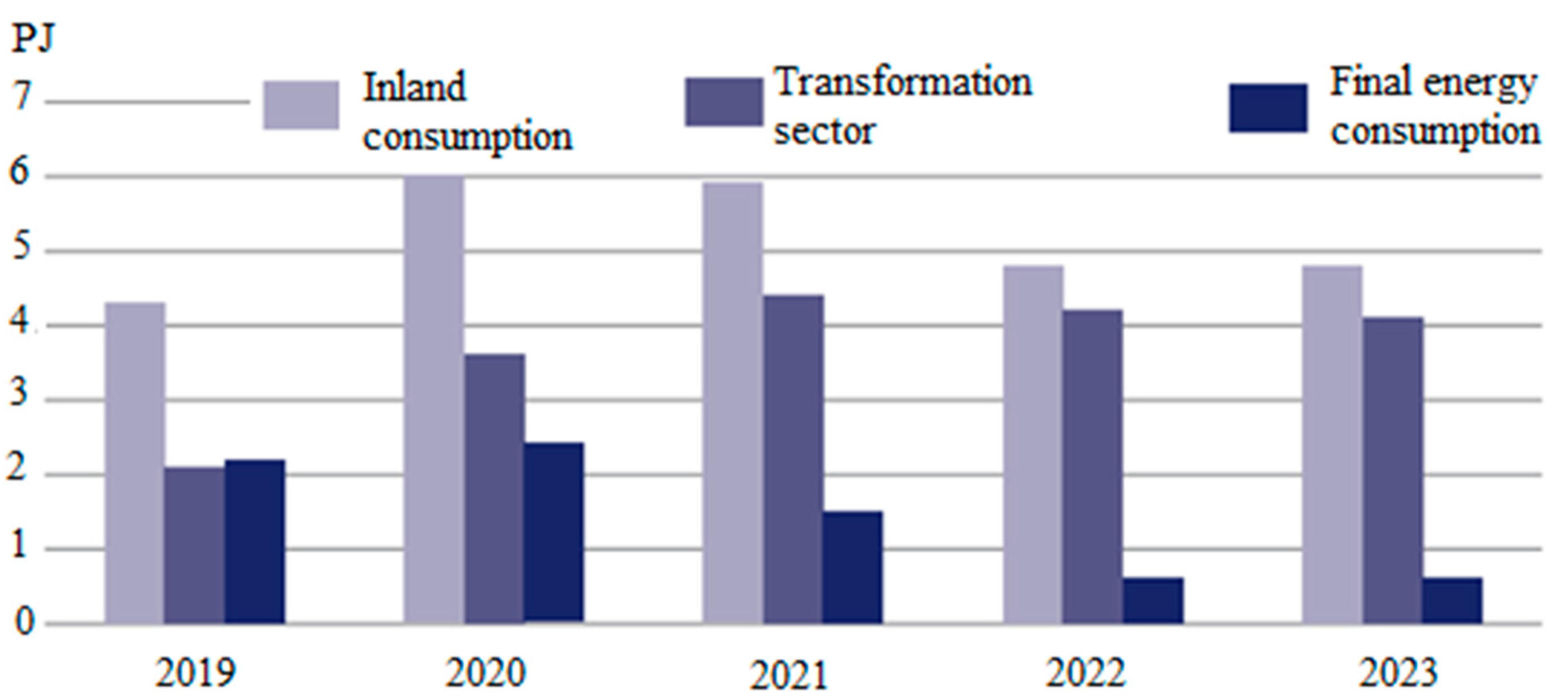
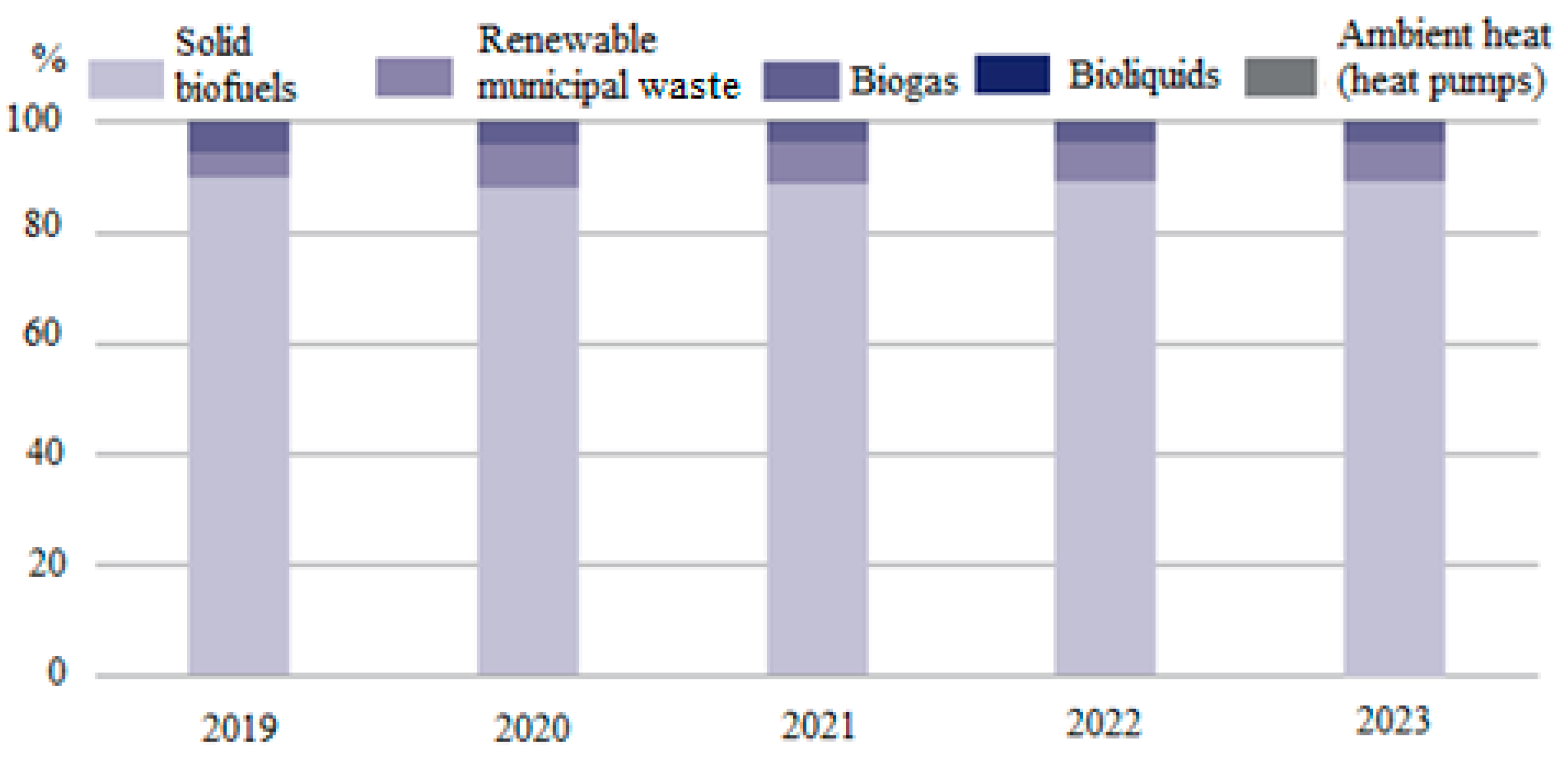
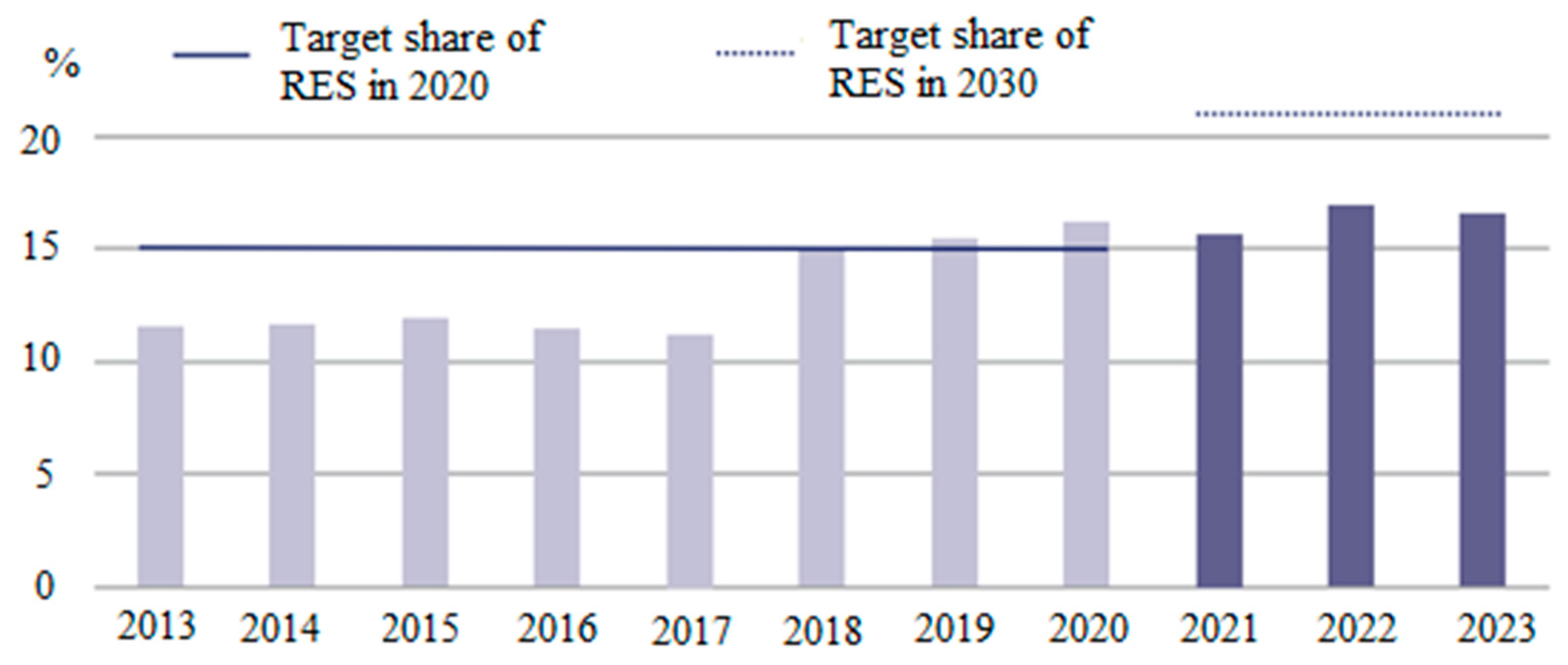

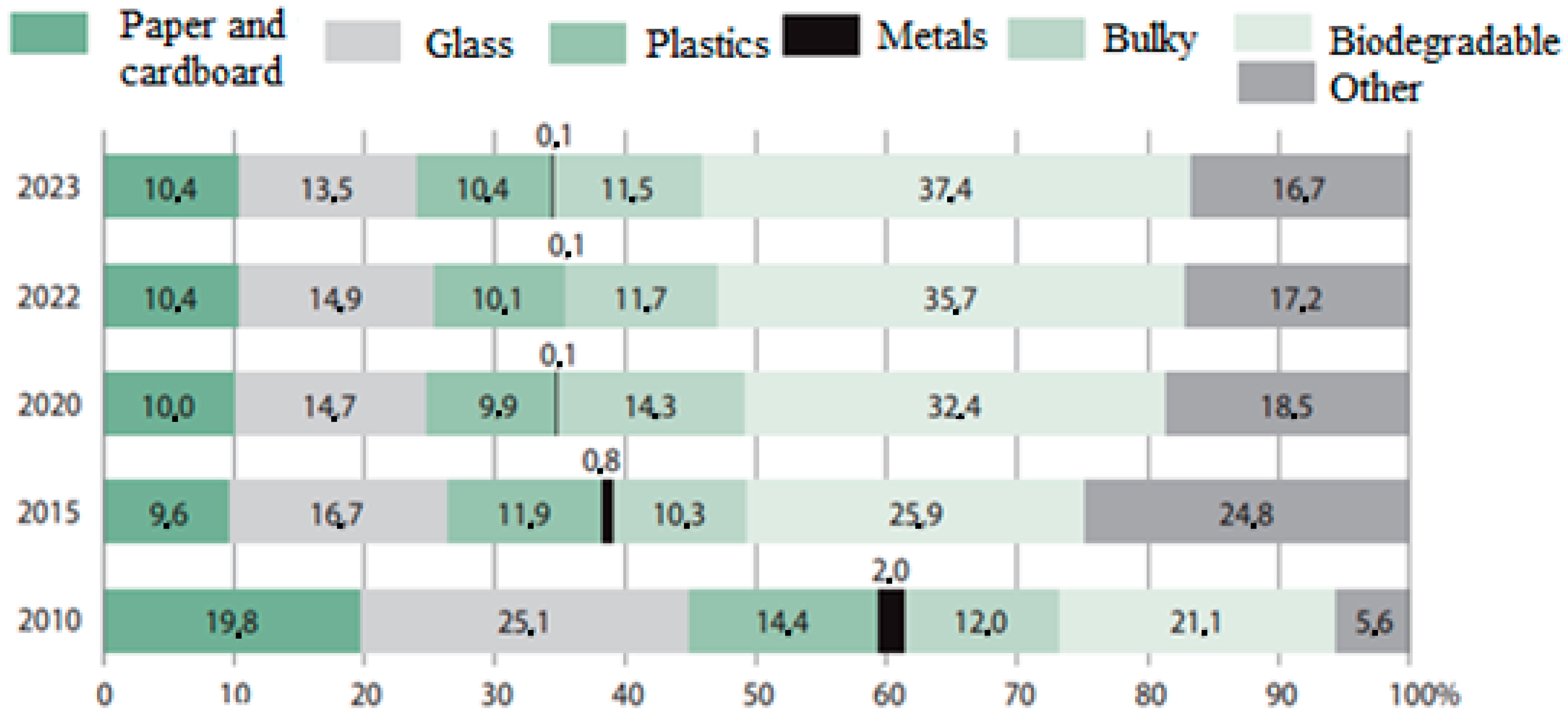
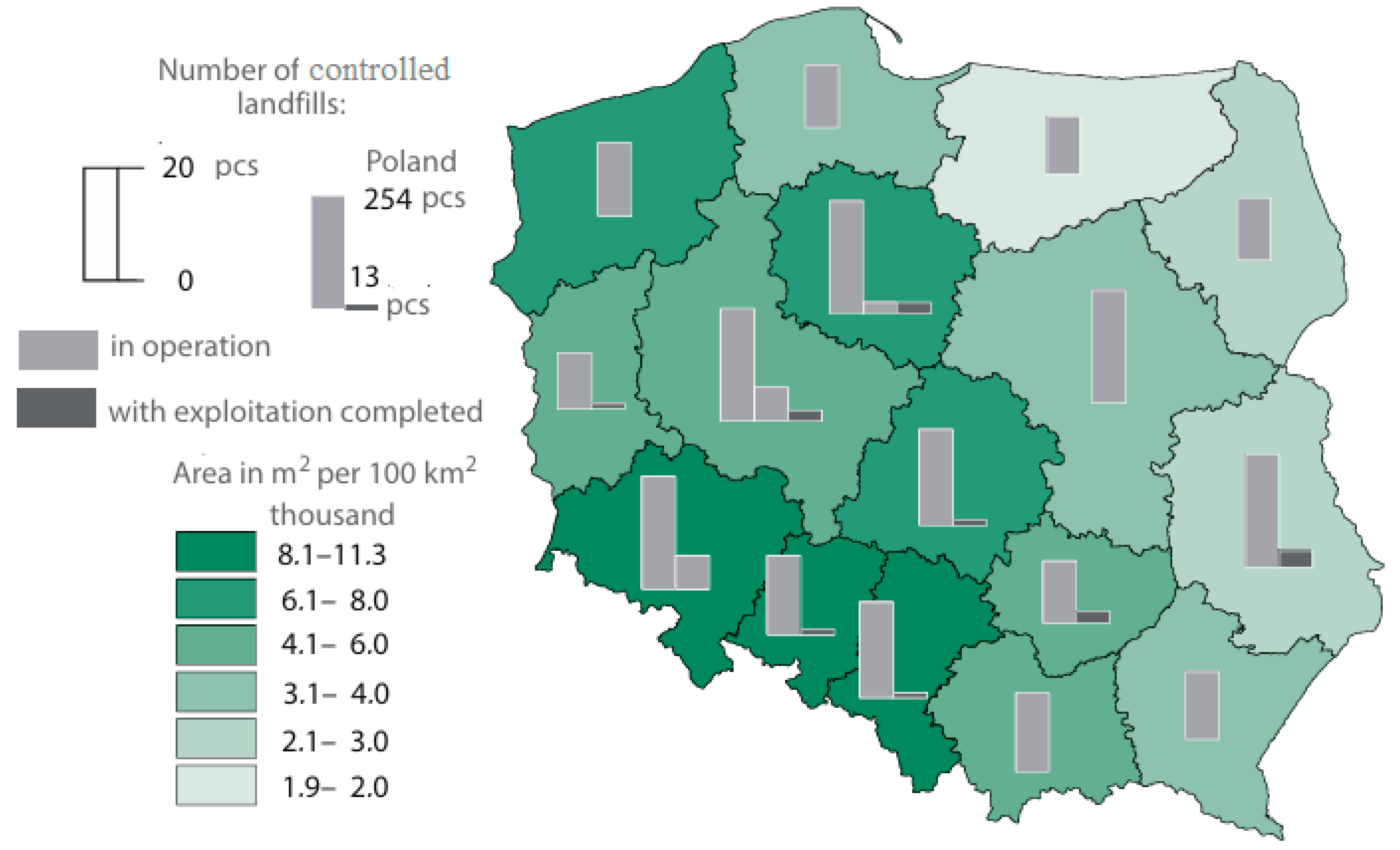
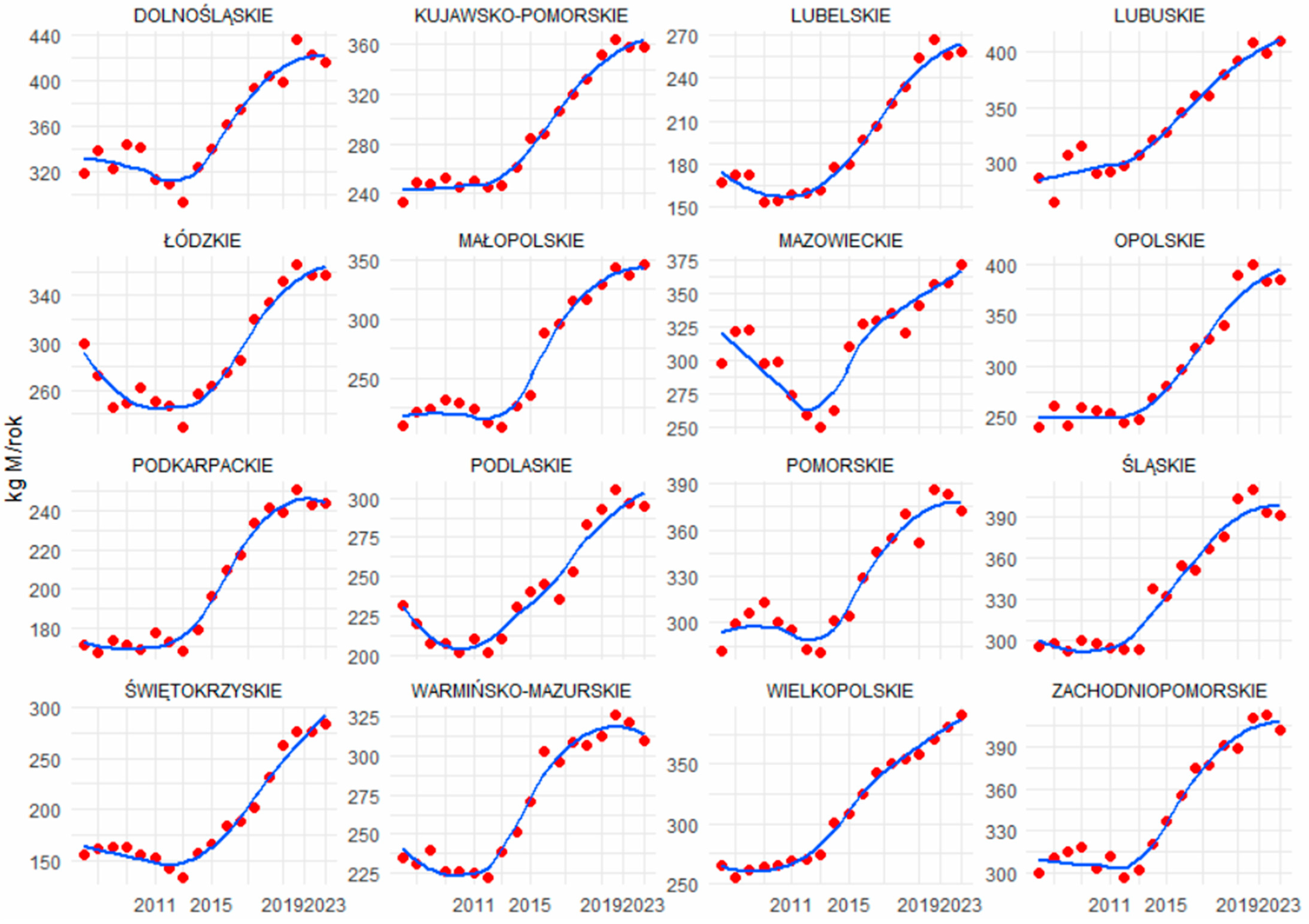

| Specification | 2017 | 2018 | 2019 | 2020 | 2021 | 2022 | 2023 | 20/19 | 21/20 | 22/21 | 23/22 |
|---|---|---|---|---|---|---|---|---|---|---|---|
| w PJ | w% | ||||||||||
| Acquisition | 3.87 | 4.17 | 4.27 | 6.01 | 6.22 | 4.87 | 4.81 | 141 | 104 | 78 | 99 |
| Domestic consumption | 3.87 | 4.12 | 4.27 | 6.01 | 6.22 | 4.85 | 4.80 | 141 | 104 | 78 | 99 |
| Consumption per batch of transformations | 1.42 | 1.54 | 2.06 | 3.58 | 4.41 | 4.26 | 4.11 | 174 | 123 | 97 | 96 |
| Final energy consumption | 2.45 | 2.57 | 2.22 | 2.43 | 1.81 | 0.61 | 0.6 | 110 | 75 | 34 | 98 |
| Manufacturing activities | 2.41 | 2.55 | 2.21 | 2.42 | 1.45 | 0.54 | 0.55 | 109 | 60 | 37 | 102 |
| Trade and services | 0.04 | 0.02 | 0.01 | 0.01 | 0.37 | 0.06 | 0.05 | 100 | 3700 | 16 | 83 |
| Incinerators | Energy Recovery | Achieved Capacity [%] | |||||
|---|---|---|---|---|---|---|---|
| 2020 [GJ/rok] | 2020 [GJ/Mg] | 2021 [GJ/rok] | 2021 [GJ/Mg] | 2022 [GJ/rok] | 2022 [GJ/Mg] | ||
| Krakowski Holding | 1,394,822 | 6.2 | 1,440,399 | 6.2 | 1,433,689 | 6.2 | 91–94 |
| ZUO Szczecin | 810,000 | 5.6 | 875,558 | 5.3 | 961,440 | 5.5 | 100 |
| Prezero Poznań | 785,000 | 3.6 | 816,592 | 3.9 | 915,847 | 4.4 | 100 |
| PUHPLECHBiałystok | 410,000 | 5.1 | 548,735 | 4.9 | 544,688 | 4.9 | 90–93 |
| PGE Rzeszów | 250,000 | 3.4 | 288,093 | 3.4 | 461,624 | 5.3 | 77–90 |
| MPO Warszawa | 220,000 | 6.7 | 277,190 | 7.3 | 277,190 | 8.0 | 58–69 |
| MZGOK Konin | 590,000 | 7.2 | 115,378 | 1.4 | 831,491 | 9.7 | 87–91 |
| Pronatura Bydgoszcz | 805,000 | 5.0 | - | - | 868,184 | 5.3 | 91 |
| Year | t | yt | ytP* α = 0.9 | (yt − ytP*)2 | ytP*·α = 0.99 | (yt − ytP*)2 | ytP* − yt − 1P* |
|---|---|---|---|---|---|---|---|
| 2007 | 1 | 85,175 | 124,150 | 1,519,019,445 | 124,150 | 1,519,019,445 | |
| 2008 | 2 | 123,128 | 89,073 | 1,159,800,238 | 85,565 | 1,411,020,589 | −38,584.9 |
| 2009 | 3 | 164,146 | 119,723 | 1,973,383,738 | 122,753 | 1,713,366,834 | 37,187.9 |
| 2010 | 4 | 181,295 | 159,703 | 466,196,258 | 163,732 | 308,466,990 | 40,978.9 |
| 2011 | 5 | 210,045 | 179,136 | 955,357,493 | 181,119 | 836,674,848 | 17,387.6 |
| 2012 | 6 | 201,629 | 206,954 | 28,348,322 | 209,755 | 66,031,009 | 28,636.1 |
| 2013 | 7 | 311,787 | 202,162 | 12,017,721,436 | 201,711 | 12,116,844,776 | −8044.7 |
| 2014 | 8 | 583,670 | 300,825 | 80,001,484,582 | 310,686 | 74,520,026,981 | 108,975.8 |
| 2015 | 9 | 657,048 | 555,385 | 10,335,169,093 | 580,940 | 5,792,326,540 | 270,253.7 |
| 2016 | 10 | 822,864 | 646,881 | 30,969,911,885 | 656,286 | 27,748,087,945 | 75,346.3 |
| 2017 | 11 | 895,395 | 805,266 | 8,123,254,728 | 821,198 | 5,505,136,302 | 164,911.8 |
| 2018 | 12 | 1,015,378 | 886,382 | 16,639,903,527 | 894,653 | 14,574,478,798 | 73,454.6 |
| 2019 | 13 | 1,196,373 | 1,002,478 | 37,595,245,820 | 1,014,170 | 33,197,790,384 | 119,517.6 |
| 2020 | 14 | 1,610,035 | 1,176,984 | 187,533,362,175 | 1,194,551 | 172,626,751,567 | 180,380.6 |
| 2021 | 15 | 1,842,994 | 1,566,730 | 76,321,876,348 | 1,605,880 | 56,222,981,447 | 411,328.9 |
| 2022 | 16 | 1,913,664 | 1,815,367 | 9,662,247,961 | 1,840,623 | 5,335,054,671 | 234,742.7 |
| 2023 | 17 | 2,042,686 | 1,903,834 | 19,279,634,476 | 1,912,934 | 16,835,546,363 | 72,311.0 |
| Specification | 2024 | 2025 | 2026 | 2027 | 2028 | 2029 | 2030 |
|---|---|---|---|---|---|---|---|
| Forecasts of biodegradable municipal waste, in thousand t | 2042.6 | 2137.2 | 2249.1 | 2360.9 | 2472.8 | 2584.6 | 2696.5 |
| Mean square error of ex-post forecasts, in thousand t | 158.1 | ||||||
| Relative error of forecasts ex post, in % | 7.74 | 7.40 | 7.03 | 6.69 | 6.39 | 6.12 | 5.86 |
Disclaimer/Publisher’s Note: The statements, opinions and data contained in all publications are solely those of the individual author(s) and contributor(s) and not of MDPI and/or the editor(s). MDPI and/or the editor(s) disclaim responsibility for any injury to people or property resulting from any ideas, methods, instructions or products referred to in the content. |
© 2025 by the authors. Licensee MDPI, Basel, Switzerland. This article is an open access article distributed under the terms and conditions of the Creative Commons Attribution (CC BY) license (https://creativecommons.org/licenses/by/4.0/).
Share and Cite
Marciniuk-Kluska, A.; Kluska, M. Energy Recovery from Municipal Biodegradable Waste in a Circular Economy. Energies 2025, 18, 2210. https://doi.org/10.3390/en18092210
Marciniuk-Kluska A, Kluska M. Energy Recovery from Municipal Biodegradable Waste in a Circular Economy. Energies. 2025; 18(9):2210. https://doi.org/10.3390/en18092210
Chicago/Turabian StyleMarciniuk-Kluska, Anna, and Mariusz Kluska. 2025. "Energy Recovery from Municipal Biodegradable Waste in a Circular Economy" Energies 18, no. 9: 2210. https://doi.org/10.3390/en18092210
APA StyleMarciniuk-Kluska, A., & Kluska, M. (2025). Energy Recovery from Municipal Biodegradable Waste in a Circular Economy. Energies, 18(9), 2210. https://doi.org/10.3390/en18092210






